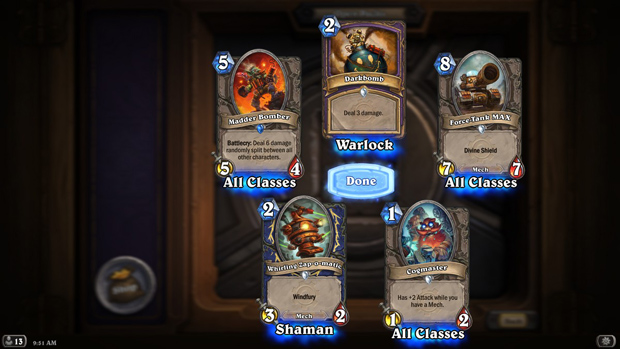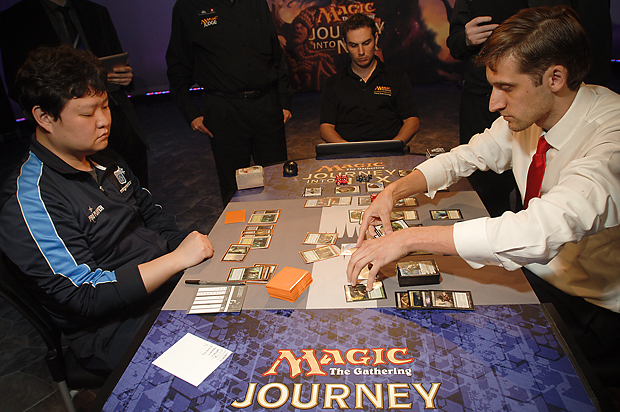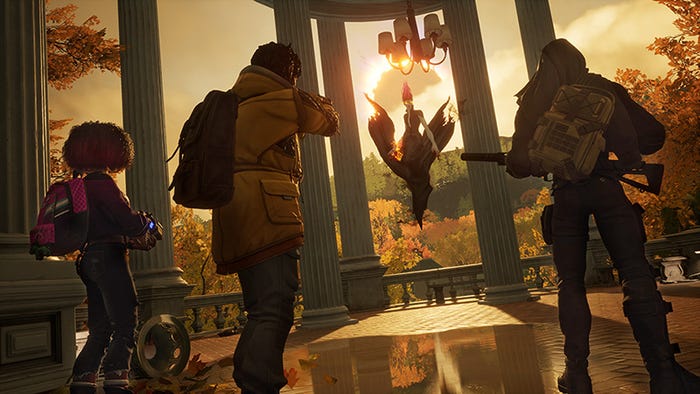When multiplayer games really aren't
A dive into what makes Trading Card Games social, and a discussion of how Blizzard's game Hearthstone stands up to these requirements.

Your Multiplayer Game Really Isn’t
There has been a disturbing trend in gaming over the last 10 years. Many games have been adding “multiplayer” modes into single player games. These games don’t need it, and don’t benefit from it. However, multiplayer has become a “checkbox” style feature that is viewed as an instant metacritic booster. It is another tag that you can add to your store page, another market to open yourself up to.
But a lot of multiplayer games don’t really require multiple players to play. This is often seen as a good business decision, because it doesn’t tie your game’s experience to its currently online population. It also gives players the option to play their games in their own timeframe, when their regular play group may be asleep or otherwise unavailable. I think it is a dangerous trend to support.
For the purposes of this article, I am going to define a multiplayer game as a game that gets better with more than one player. In particular, it gets better because another player performs a role which a computer entity cannot easily fill by today’s industry standard technologies. I will focus on a Hearthstone as a case study here, because it is a relatively recent release that is widely viewed as a great success. We’ll discuss why Hearthstone is a great success, but not truly a multiplayer game.
Hearthstone: Multiplayer in Name Only
Hearthstone is the latest multiplayer game released by Blizzard. It is a head-to-head collectible card game where every game is played against another player once you complete the tutorial. Trading Card Games are a notably social game type in the physical board game world; with people meeting up to trade cards, talk about deck builds and useful card combinations, and playing against each other in tournaments on a regular basis. Modeled after this game type, hearthstone emulates many aspects of the TCG scene, but removes all truly social elements from it.

Notably, Hearthstone is a Collectible Card Game, and not a Trading Card Game. A person can work to collect all of the cards in each set, but they cannot do it with the help of anyone else. There is no system to trade, buy, or sell cards with other players at all. There is a buying/selling mechanic with the game itself at fixed prices, but all of the social elements of finding a person who has your desired card, and working out a fair deal for it have been removed.

Hearthstone has also removed all chat between players (except for the friend chat through Battle.Net itself). No longer can a player discuss builds with their opponents, or talk about strange card combos. No longer can a person ask for clarification when using unusual, or ill-written cards (like all of those cards that grant spare parts). The first time I came up against The Clockwork Gnome,

I had no idea what a spare part could be, much less how I should expect to respond. I couldn’t ask my opponent, because there was no chat, and I only had 30 seconds on my turn to figure out what it would do through an out of game internet browser.
One of the most important aspects of a TCG in the physical world is the tournament scene. Playing against a group of people competitively, climbing the ranks, and winning prizes. The arena in Hearthstone provides a similar experience, but has removed all social aspects from it. You do not get organized into groups of players, able to see how you stand against the rest. You are simply dropped into a series of games, and given a rating at the end. There is no “standings” to be #1 in, there are no brackets to predict your opponents. There are only 3 to 13 disjoint, individual games against completely random opponents to qualify for a prize pack. Other than seeing their usernames, each game may as well be against a computer opponent with randomized decks and move timings.

Now, please do not get me wrong. Hearthstone is a marvelous game that it a blast to play. It is intuitive, responsive, and has a huge amount of strategic depth. However, it also may as well be single player. You cannot talk to, trade with with, or compare yourself against other players effectively. You can rest easy knowing that you are playing against other players. In actuality, knowing that there is not a computer on the other side of that screen may make people more comfortable with a computer based card game. But by no stretch of the imagination is it truly multiplayer.
The Point of Multiplayer
I think that this distinction is very important to point out, because not being multiplayer represents a shift in how players view each other in a game. Rather than having a community of equals who are all playing and progressing together, removing these critical aspects of Hearthstone’s multiplayer have changed the dynamics of player relationships. In Hearthstone, another player can be nothing except an obstacle to overcome. You can never work cooperatively with a friend, never rely on them to help you finish your collection, nor can you ever sit down to meet a new member of the community through the game. Any other account on the Hearthstone servers can only ever be something to conquer rather than something to work with.
If the point of any multiplayer game is to play a game with multiple players, I think Hearthstone has grandly failed. In no way can playing with another player affect your game, aside from being a possibly more entertaining AI. While AI for card games is a tough problem to solve, many games have made entertaining AI personalities to face off against. The tutorial section of Hearthstone even adds in opponent emotes, showing that the whole experience can be mimiced. A Multiplayer game must add real game benefit when adding players. Otherwise, you are misleading yourselves, and misleading your customers.
Read more about:
BlogsAbout the Author(s)
You May Also Like













